
Stevia is a sweet sugar substitute extracted from the leaves of the plant species Stevia rebaudiana native to Paraguay and Brazil.

Apocynaceae is a family of flowering plants that includes trees, shrubs, herbs, stem succulents, and vines, commonly known as the dogbane family, because some taxa were used as dog poison. Members of the family are native to the European, Asian, African, Australian, and American tropics or subtropics, with some temperate members. The former family Asclepiadaceae is considered a subfamily of Apocynaceae and contains 348 genera. A list of Apocynaceae genera may be found here.
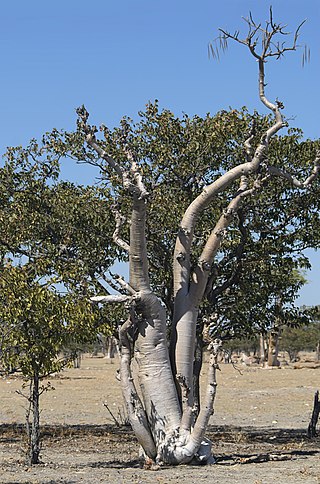
Moringa is the sole genus in the plant family Moringaceae. It contains 13 species, which occur in tropical and subtropical regions of Africa and Asia and that range in size from tiny herbs to massive trees. Moringa species grow quickly in many types of environments.

Stapelia is a genus of low-growing, spineless, stem succulent plants, predominantly from South Africa with a few from other parts of Africa. Several Asian and Latin American species were formerly included but they have all now been transferred to other genera. The flowers of certain species, most notably Stapelia gigantea, can reach 41 cm (16 inches) in diameter when fully open. Most Stapelia flowers are visibly hairy and generate the odor of rotten flesh when they bloom.

Lablab purpureus is a species of bean in the family Fabaceae. It is native to sub-Saharan Africa and India and it is cultivated throughout the tropics for food. English language common names include hyacinth bean, lablab-beanbonavist bean/pea, dolichos bean, seim or sem bean, lablab bean, Egyptian kidney bean, Indian bean, bataw and Australian pea. Lablab is a monotypic genus.

Ipomoea aquatica, widely known as water spinach, is a semi-aquatic, tropical plant grown as a vegetable for its tender shoots. I. aquatica is generally believed to have been first domesticated in Southeast Asia. It is widely cultivated in Southeast Asia, East Asia, and South Asia. It grows abundantly near waterways and requires little to no care.

Cyclanthera pedata, known as caigua, is a herbaceous vine grown for its edible fruit, which is predominantly used as a vegetable. It is known from cultivation only, and its use goes back many centuries as evidenced by ancient phytomorphic ceramics from Peru depicting the fruits.

Solanum adscendens, the sonoita nightshade, is a plant native to the Americas. It has been found in Mexico, Costa Rica, El Salvador, Guatemala, Honduras, Nicaragua, Bolivia, Colombia, Ecuador, Paraguay, Corrientes in Argentina, Bahia and Rio Grande do Sul in Brazil, and Texas and Arizona in the United States. In addition, this plant has also been naturalized in parts of Africa.
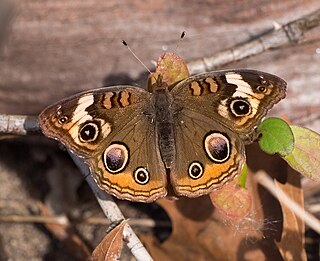
Junonia coenia, known as the common buckeye or buckeye, is a butterfly in the family Nymphalidae. Its range covers much of North America and some of Central America, including most of the eastern half of the US, the lower to middle Midwest, the Southwest, southern Canada, and Mexico. Its habitat is open areas with low vegetation and some bare ground. Its original ancestry has been traced to Africa, which then experiences divergence in Asia. The species Junonia grisea, the gray buckeye, is found west of the Rocky Mountains and was formerly a subspecies of Junonia coenia.

Solanum nigrum, the European black nightshade or simply black nightshade or blackberry nightshade, is a species of flowering plant in the family Solanaceae, native to Eurasia and introduced in the Americas, Australasia, and South Africa. Ripe berries and cooked leaves of edible strains are used as food in some locales, and plant parts are used as a traditional medicine. Some other species may also be referred to as "black nightshade".

Trichosanthes dioicaRoxb., also known as pointed gourd, is a tropical perennial cucurbit plant with its origin in the Indian subcontinent. It is also known as parwal, palwal, potol, or parmalin in different parts of India and Bangladesh. The plant propagated vegetatively and grows with training on a support system as pencil-thick vines (creepers) with dark-green cordate (heart-shaped) simple leaves. It is a well-developed dioecious plants having distinct male and female flowers on staminate and pistillate plants, respectively. The fruits are green with white or no stripes' and have unpalatable seeds. Size can vary from small and round to thick and long — 2 to 6 inches. It thrives well under a hot to moderately warm and humid climate. The plant remains dormant during the winter season and prefers fertile, well-drained sandy loam soil due to its susceptibility to water-logging.
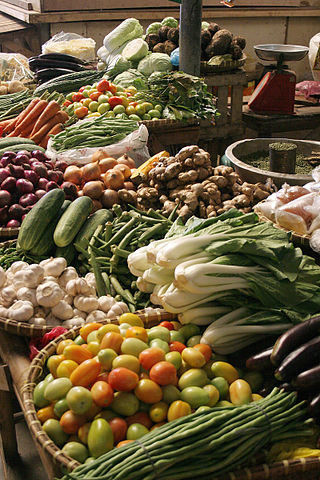
Vegetables are parts of plants that are consumed by humans or other animals as food. The original meaning is still commonly used and is applied to plants collectively to refer to all edible plant matter, including the flowers, fruits, stems, leaves, roots, and seeds. An alternative definition of the term is applied somewhat arbitrarily, often by culinary and cultural tradition. It may exclude foods derived from some plants that are fruits, flowers, nuts, and cereal grains, but include savoury fruits such as tomatoes and courgettes, flowers such as broccoli, and seeds such as pulses.
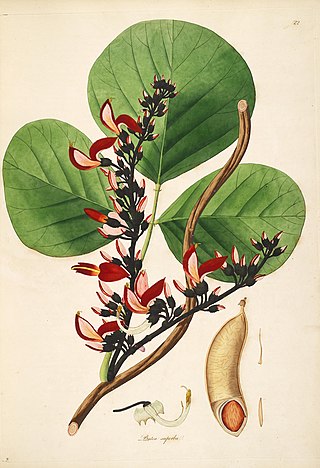
Butea superba is a vining shrub in the legume family Fabaceae, native to India and mainland Southeast Asia. It is thought by locals to be an aphrodisiac, among other effects.

Caralluma is a genus of flowering plants in the family Apocynaceae, consisting of about 120 species.
Caralluma edulis is a succulent species in the plant family Apocynaceae, native to India and Pakistan.

Ceratocystis fimbriata is a fungus and a plant pathogen, attacking such diverse plants as the sweet potato and the tapping panels of the Para rubber tree. It is a diverse species that attacks a wide variety of annual and perennial plants. There are several host-specialized strains, some of which, such as Ceratocystis platani that attacks plane trees, are now described as distinct species.

Acalypha indica is an herbaceous annual that has catkin-like inflorescences with cup-shaped involucres surrounding the minute flowers. It is mainly known for its root being attractive to domestic cats, and for its various medicinal uses. It occurs throughout the Tropics.
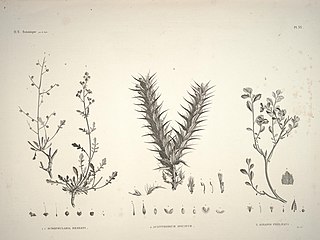
Blepharis edulis is a species of plant in the family Acanthaceae. It is found in India, Pakistan and Iran as well as Egypt. It is a small plant, covered in soft, grey hairs. It has many serrated leaves, that have prickles attached to them. The flowers are a yellowish color. Its capsules contain two seeds, that are heart-shaped, smooth, shining, and brownish in color. In India, it is commonly known as Dakhni chappar or Utangan.

Senna italica, the Port Royal senna, Italian senna, or Senegal senna is a legume tree in the genus Senna. It is recognized by many other common names based on the regions it grows in. In India, it is used to produce a powder for treating hair-related diseases which is known as “neutral henna”. Whereas, in some parts of the world, this species is cultivated for the leaves which yield the drug senna, known commonly as Senna glycoside, which in turn is the base for a laxative. Senegal senna is easily distinguishable through its many distinctive features. There are 3 subspecies of this plant based on the size of the inflorescence and the length of the petiole. The subspecies are italica, micrantha, and arachoides. In many regions, this plant is cultivated commercially and medicinally.

Ludwigia adscendens, the water primrose, is a species of flowering plant in the evening primrose family. Its native distribution is unclear. It is now a common weed of rice paddies in Asia and occurs also in Australia and Africa, but may have originated in South America.



















